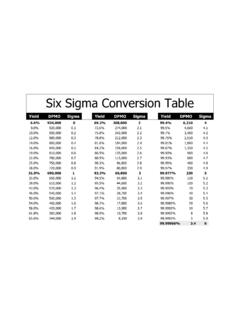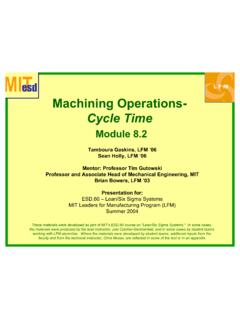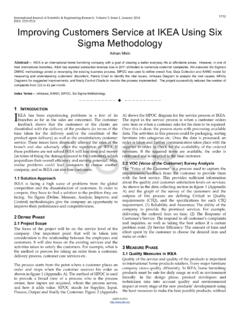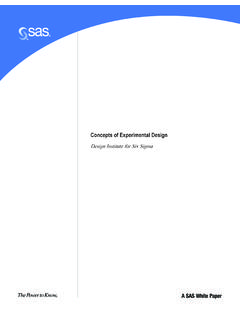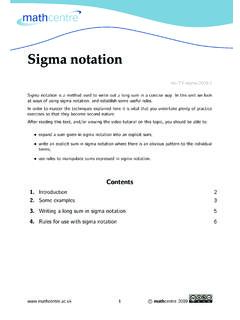Transcription of DMAIC- The 5 Phases of Lean Six Sigma
1 dmaic : The 5 Phases of lean Six SigmaStart your journey towards increased revenue, reduced costs and improved collaboration by using lean Six Sigma Process / Connect with us: Twitter / LinkedInCopyright 2012 Go lean Six Sigma . All Rights of is dmaic and lean Six Sigma ? Beginning dmaic : Select the Right Projects the Problem the problem by developing a Problem Statement the goal by developing a Goal Statement process by developing maps of the process your customer and their requirements Out the Current Process how the process currently performs for what might be causing problem a plan to collect the data your data is reliable your project charter the Cause of the Problem examine the process inspect the data potential cause(s) of the problem the cause(s) of the problem your Project Charter and Verify the Solution(s)
2 Solutions that might fix the problem the practical solutions maps of processes based on different solutions the best solution(s) the solution(s) improvement the Solution(s) improve the process using lean principles the process is being managed and monitored properly the improved process throughout organization new knowledge to other processes in your organization and celebrate your success Go lean Six Sigma 13 The Basics of lean Six Sigma What is dmaic and lean Six Sigma ? lean Six Sigma is simply a process for solving a problem. It consists of five basic Phases : Define, Measure, Analyze, Improve, and Control. This process is also known as dmaic (pronounced duh-may-ik ), its and Six Sigma complement each other.
3 lean accelerates Six Sigma , delivering greater results than what would typically be achieved by lean or Six Sigma these two methods gives your improvement team a comprehensive tool set to increase the speed and effectiveness of any process within your organization resulting in increased revenue, reduced costs and improved Basics of lean Six Sigma Beginning dmaic : Select the Right ProjectsBefore beginning any process improvement project, it s vital that you choose projects that are good candidates for improvement. A good project for improvement:n Has an obvious problem within the processn Has the potential to result in increased revenue, reduced cost or improved efficiencyn Has collectable dataDMAIC ( lean Six Sigma ) is also a system of management that results in a steady pipeline of projects that are ready for improvement.
4 There are obstacles to smooth operations in any business, and lean Six Sigma provides guidelines to help you select the right projects at the right time. Once projects are selected, you and your improvement team(s) can use dmaic to further refine the projects and deliver quantifiable, sustainable , on to the dmaic process!The Basics of lean Six Sigma the ProblemWhat problem would you like to fix? The Define Phase is the first phase of the lean Six Sigma improvement process. In this phase, the leaders of the project create a Project Charter , create a high-level view of the process, and begin to understand the needs of the customers of the process.
5 This is a critical phase of lean Six Sigma in which your teams define the outline of their efforts for themselves and the leadership (executives) of your the problem by developing a Problem Statement Confirm the process is causing this stage the team should have access to some existing data that shows an ongoing problem. They will refine the data during data collection, but they must confirm that there are indications of an the problem is high priority and will have a high established the existence of a process issue, the team must create a Problem Statement. The Problem Statement includes:n Severity: How big is the problem? This can consist of the percentage of the time there are errors, the number of late orders per month, etc.
6 Be specific to put data into perspective. Specific data may not be available right away, so the team can fill in the blanks later during the Measure Business Impact: What is the pain felt by the business or why should anyone care about the solving this issue? Will solving the problem result in greater revenue or cost savings?n Specific Area: What department or what units are involved?Confirm resources are there people close to the issue who can spend time working on the issue? Is there someone in a leadership position who would like to see the issue resolved? It is critical to have some form of team leader (also known as a Black Belt or Green Belt), as well as someone in a leadership position, who is called a Sponsor or Project Champion, involved with the project.
7 Team members can come from different areas but should all have some connection to the project Basics of lean Six Sigma the goal by developing a Goal Statement The Goal Statement should be a direct reflection of the Problem Statement. For example, if orders are 10% late, then the goal might be to cut that down to 5% late. This statement defines measurable, time-bound terms of exactly when the team and project will be considered process by developing maps of the processThe team begins with the a bird s eye view of the process, also known as a high-level process map. The classic tool here is called a SIPOC which stands for Suppliers, Inputs, Process, Outputs and Customers.
8 This initial one-page document is used throughout the life of the the high-level map is completed, the team can choose a key area of the process to conduct a deep dive into more process detail. This is called Detailed Mapping. This can be done in lanes representing departments, or it can be done as a simple your customer and their requirementsThe focus of each project is the customer of the process. The customer is defined as the individuals or groups who receive the goods or services of the process. Customers can be external to the organization or an internal component of the the Define phase, the team must contact customers to better understand their requirements of the process, or the Voice of the Customer.
9 After interviewing or surveying customers, the team must translate that information into measurable requirements that will give the team insight on how to improve the process or solve the Basics of lean Six Sigma Out the Current ProcessHow does the process currently perform? Measurement is critical throughout the life of the project and as the team focuses on data collection initially they have two focuses: determining the start point or baseline of the process and looking for clues to understand the root cause of the process. Since data collection takes time and effort it s good to consider both at the start of the how the process currently performsFirst, your team must establish the current state, or the baseline of the process before making any changes.
10 The baseline becomes the standard against which any improvement is measured. This is a key step as the data collected will be used throughout the life of your for what might be causing problemTo do this, your team collects data and reviews it to try to uncover the reasons, or the root cause for Waste in the process or defects as a result of the a plan to collect the dataOnce the team has determined how to find both baseline and root cause data, they must consider where to get the data, how much to get and who will do the collecting. A well-thought out data collection plan is critical as the data that is gathered must be accurate and your data is reliableBy defining, testing and refining their measurements throughout the life of the project, the team will be able to make good decisions on sound information.


